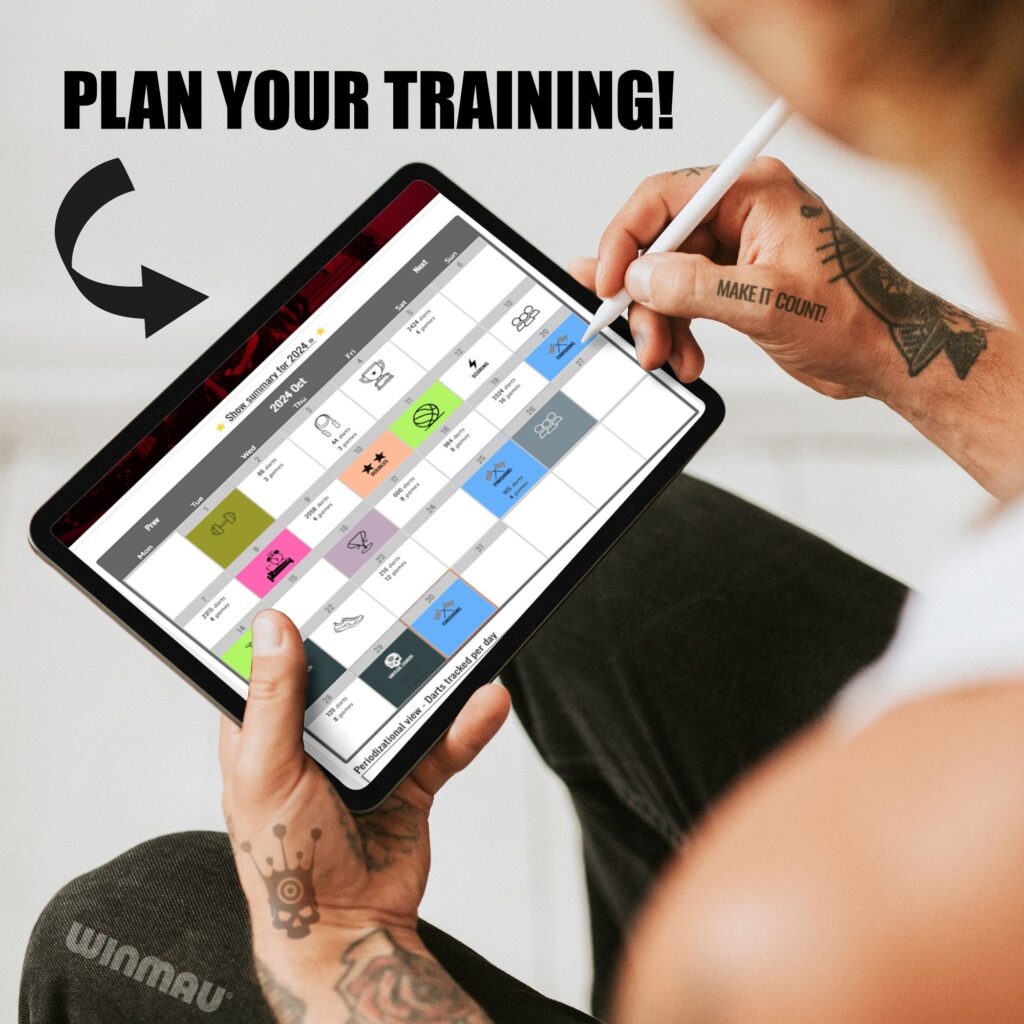Many darts players (especially beginners) don’t really have an intention or plan for their training. They just go to their board, pick up their darts and start to chuck them at treble 20 until they get bored and then start a few legs of 501 against a bot.
Eventually they will of course improve but most of us are here to improve as fast as possible.
First of all, a well-designed training plan is something that will bring you closer to your goals for darts and more quickly.
Plan your darts training!
If you start to look at your training sessions more seriously and a try to adapt a few smarter ways to spend your hours at the board, you’ll get many benefits. You will be more inspired to learn and to improve, you’ll boost your self confidence and much more. Therefore you will also improve faster.
We highly recommend players who’re serious about darts to develop a training schedule and periodization plan and try to stick to it.
New tools
On the Training log page on GoDartsPro you can now add details to your following weeks and months to plan your training days. You can also mark dates when you plan to avoid darts training and instead maybe going to the gym, spinning class etc.
This will also show an honest view of how much you are able to practise darts per week. Its purpose is to give you a birds-eye view of how you’re training.
You can also set goals for how many darts you plan to throw, game sessions to play and you can also attach a certain playlist for the day. This way you can plan your week and have different days in the week to practise finishing, power-scoring etc. Be creative and make your training more fun!
And don’t worry, even a poor plan is almost always better than no plan at all!

Training calendar
Make sure also to vary your plan for number of thrown darts and games to play during the week and also vary the intensity during the week. Make sure to have days when you really push yourself with a few tougher (perhaps longer) games as well as days where you try out new games or play games you know you’re good at.
This way you’ll adopt something called periodization training which is commonly used in many other sports.
Periodization training
The goal of periodization training is to maximize the players performance by gradually increasing the intensity in exchange for volume-loading over time, helping the client reach their peak potential.
It is also defined as the planned manipulation of training variables (hours, darts thrown, intensity) in order to maximize training adaptations and to prevent the onset of overtraining syndrome.
There are many interesting articles about periodization training and if you’re interested to learn more about this, just Google for periodization training. For example, for archers this is commonly used to maximise their training and to plan to reach their peak performance for an important competition.
The two Time Olympic Archery Medalist Jake Kaminski, wrote a book (“Training for
archery”) about his way to adapt periodization training and also got a few interesting videos about it.
Rest and recovery
When looking at the stats from members on GoDartsPro, taking a day or two off from darts, for rest and recovery, seems to be the hardest part for most of us (even though the Virtual Coach suggests it every now and then).
Rest and recovery are crucial for most players to prevent overuse injuries and burnout. It’s essential to listen to the body and take rest days when needed. Darts players should plan for at least one or two rest days per week, allowing the muscles to recover and reducing the risk of injury.
Rest and recovery can also include stretching to help relieve muscle tension and prevent soreness. You can also benefit from physiotherapy or massage therapy to treat or prevent injuries.
Planning for days of recovery or other training forms than darts will give you a positive injection when you’re back at the board with a fresh mind.

Conclusions
We all know how easy it is to have plans for any kind of training or exercises, but it is tougher to maintain them and to stick to the plan. When you go to the gym in January it can be crowded since so many want to start out a new habit for the year.
But after a few weeks there are less and less people showing up, and they probably have thousands of “good” reasons why they don’t continue to go to the gym…
But if you really want to improve on a steady basis, make a plan for the following weeks, fill out the training calendar with different goals and playlists, and you’ll make it easier for yourself to stick to it.
Whenever you login to GoDartsPro you will your pre set plan for the day, reminding you that
you’re on a journey to become the best darts player you can be.
Enjoy your darts and make it count! Anders
—–ENDS—–
Words: Anders Ostman
Images: GoDartsPro








